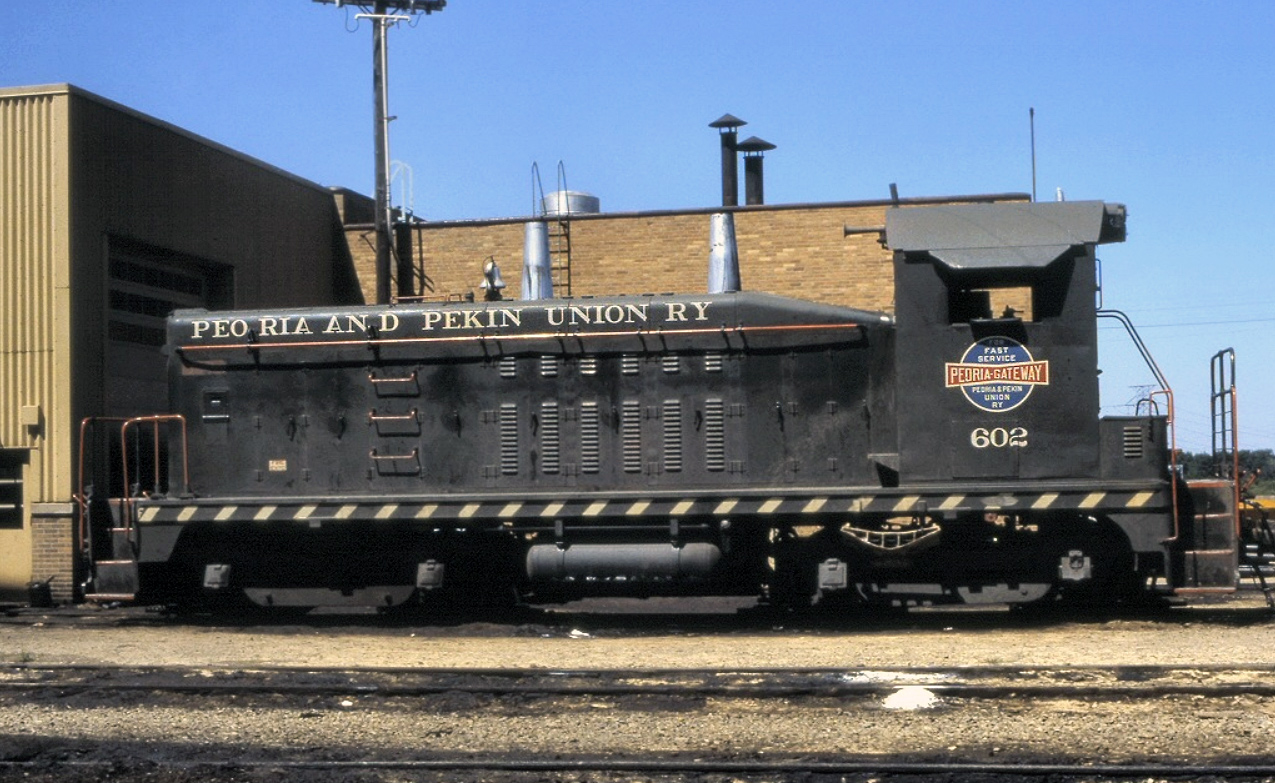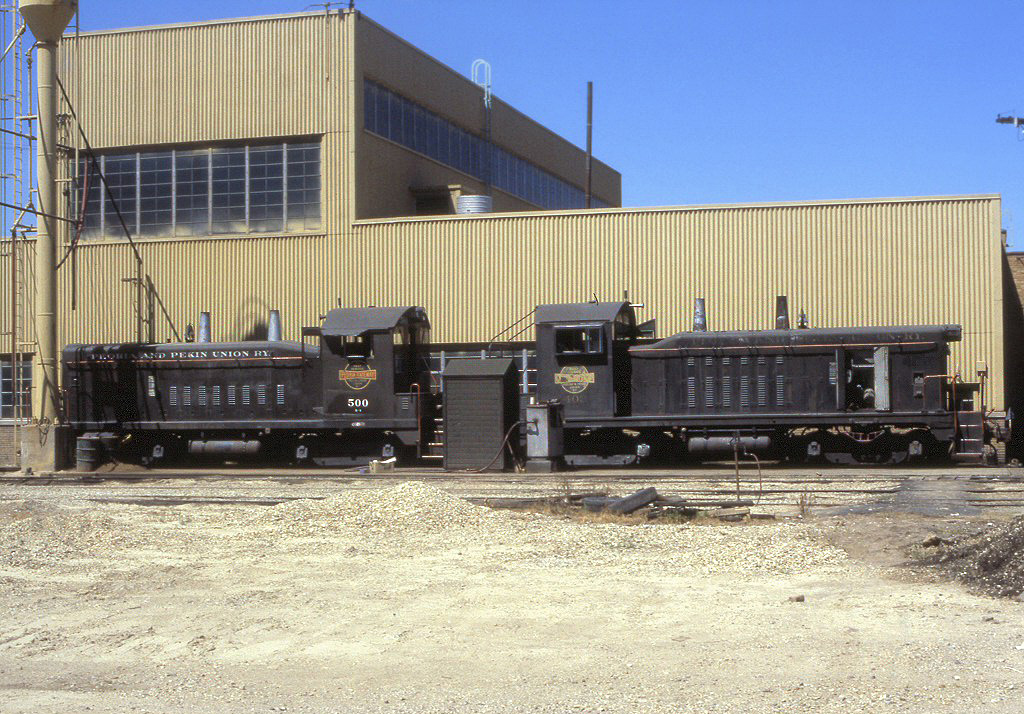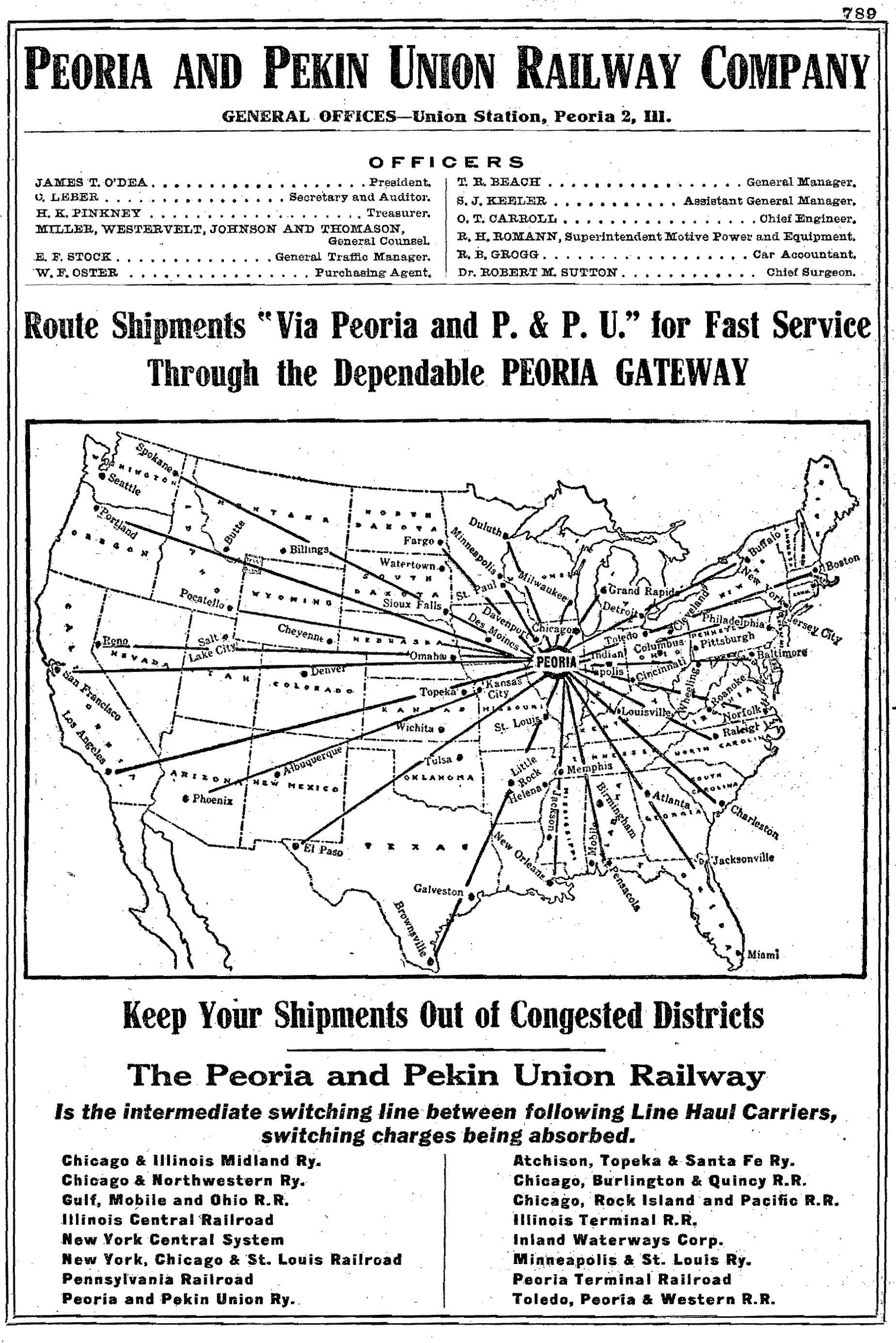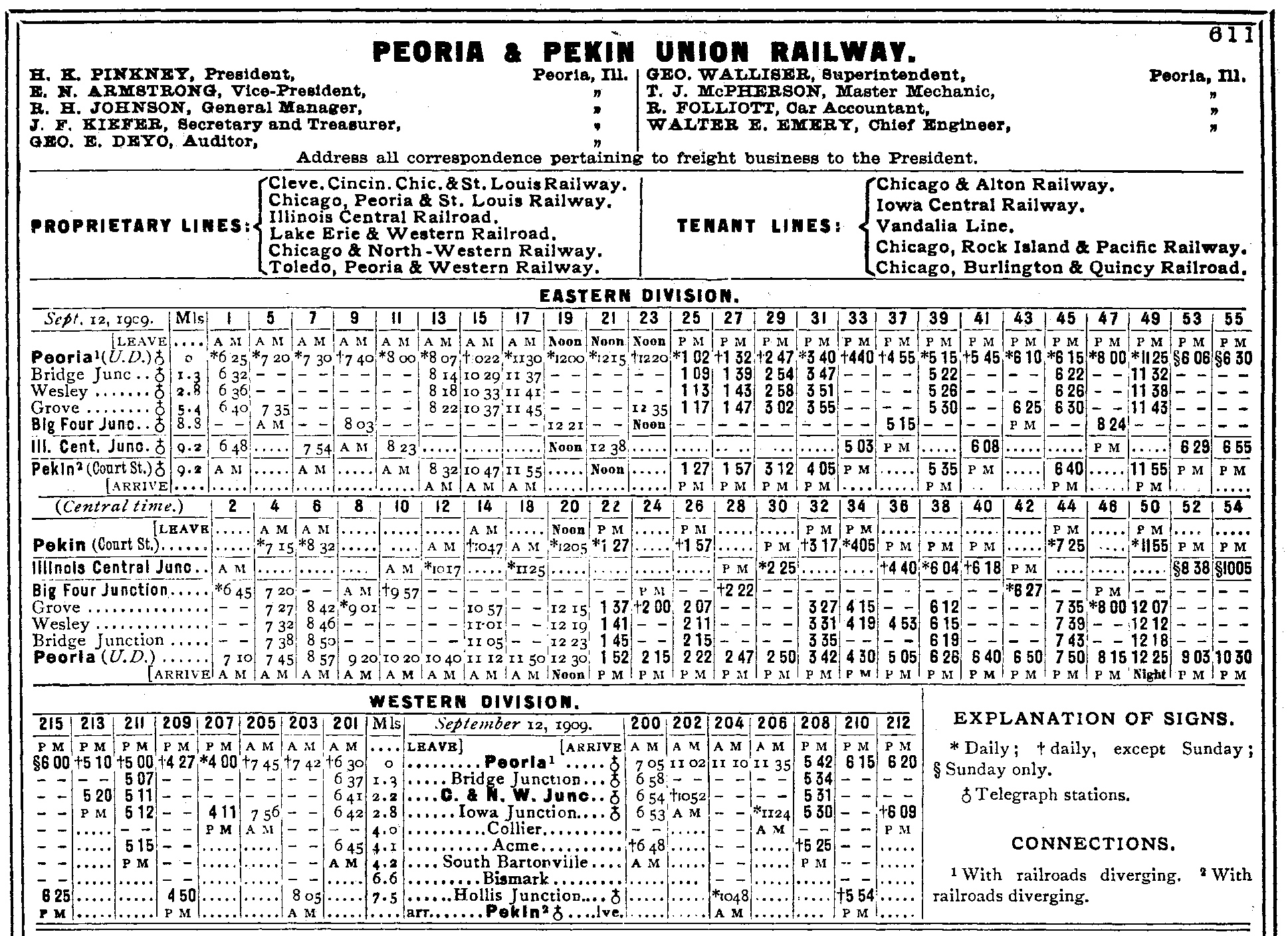Peoria and Pekin Union Railway: Map, Timetables, History
Published: August 15, 2024
By: Adam Burns
The Peoria and Pekin Union Railway (P&PU) is a storied short line with a rich history that mirrors the development of the American Midwest’s rail infrastructure.
Positioned in Central Illinois, the P&PU was an important terminal road between its home cities for decades. In August, 2004, Genesee & Wyoming acquired the P&PU and currently operates the former system as the Tazewell & Peoria Railroad.
This article delves into the origins, growth, operational changes, and legacy of the P&PU, illustrating its pivotal role in regional transportation.
 Peoria & Pekin Union SW7 #902 lays over at the railroad's shops in Peoria, Illinois in August, 1978. Rob Kitchen photo.
Peoria & Pekin Union SW7 #902 lays over at the railroad's shops in Peoria, Illinois in August, 1978. Rob Kitchen photo.Early Beginnings
The Peoria and Pekin Union Railway was established in 1880, in the wake of burgeoning industrial growth in the region. The railway was born from the need to handle the increasing volume of freight traffic in the Peoria and Pekin areas, cities located along the Illinois River.
Early railroads in Illinois had already fostered the region's economic expansion by providing necessary connections between local manufacturers, agricultural producers, and national markets. However, by the late 19th century, a more integrated network was required to manage the escalating transport demands efficiently.
It was common for small cities to be serviced by a multitude of railroads, each operating its own yards, stations, and other terminal facilities. This was precisely the situation in Peoria, Illinois, until September 28, 1880.
On that date, the Wabash, St. Louis & Pacific (later known simply as the Wabash), the Indiana, Bloomington & Western (eventually part of the Big Four's Peoria & Eastern), the Peoria, Decatur & Evansville (later part of the Illinois Central), and the Peoria & Jacksonville (later the Chicago & Illinois Midland) came together to form the Peoria & Pekin Union Railway (P&PU). This newly established entity was a quintessential example of a switching and terminal company, designed to consolidate operations and streamline the complexities of managing multiple railroads in a single urban area.
Before the P&PU, each of these railroads operated its own yard, roundhouse, and station in Peoria, creating a fragmented and inefficient rail system.
The primary goal of forming the P&PU was to unify these scattered facilities, simplifying operations and coordination. Additionally, the P&PU took over two lines connecting to Pekin, located ten miles south of Peoria.
The western route, built in 1864 by the Peoria, Pekin & Jacksonville, crossed the Illinois River at Pekin. The eastern route, constructed by the Peoria & Springfield in 1872, had a bridge on the south side of Peoria. In 1884, the P&PU abandoned the bridge at Pekin along with a mile of track beyond Hollis.
The P&PU commenced operations in February 1881, initially using rented locomotives. By the end of that year, the company had acquired eight 0-4-0 switchers, four from Hinkley and four from Portland.
Growth and Expansion
In 1882, it expanded its fleet with a second-hand passenger engine and three additional switchers from the Peoria & Springfield. To service these locomotives, as well as the engines of its joint owners, the P&PU opened a roundhouse at Bridge Junction. Initially featuring 30 stalls, the roundhouse was later enlarged to accommodate 34 stalls.
Peoria Union Station opened its doors in October 1882, featuring a block-long trainshed that covered five tracks. In 1900, the station was upgraded with a longer shed spanning seven tracks, further enhancing its capacity and operational efficiency.
This consolidation and modernization allowed the P&PU to serve as a cornerstone of Peoria’s rail infrastructure, streamlining operations for the benefit of all its stakeholder railroads and significantly improving logistical efficiency in the region.
By 1906, the P&PU was managing an impressive volume of over one million rail cars annually and operated 16.7 miles of track. Anticipating future growth and the need for expanded capacity, the railroad took a proactive step the following year by inaugurating a large new yard in East Peoria.
This strategic investment not only ensured the P&PU could handle increasing traffic but also solidified its position as a critical hub in the region's rail network.
System Map (1952)
Operational Highlights
During its peak, the P&PU played a crucial role in managing the logistic needs of the Peoria Union Station, one of the largest and busiest railroad terminals in downstate Illinois. This facility handled a significant amount of passenger traffic alongside freight, making it a bustling nexus of activity in the early to mid-20th century.
Passenger Service
Although the primary focus of the P&PU was freight traffic, it also facilitated passenger services through Peoria Union Station. This terminal was used by prominent railroads throughout the Midwest such as the Rock Island, Santa Fe, and Burlington.
The P&PU, though, was early victim of the automobile. Due to the railroad's local operation it was quick to drop passenger service, ending all of its own trains between both cities by 1931.
Timetable (1910)
Freight Innovations
The P&PU was known for several innovative approaches to handling freight:
- **Efficient Interchanging:** The railway streamlined the interchange process between different railroad companies, reducing delays and operational bottlenecks.
- **Diverse Commodities:** The variety of freight handled by the P&PU was impressive, ranging from coal and agricultural products to manufactured goods and raw materials.
Diesel Roster (All-Time)
| Road Number | Model | Builder | Serial Number | Completion Date | Notes |
|---|---|---|---|---|---|
| 100 | HH600 | Alco | 68728 | 4/1936 | - |
| 300 | S-2 | Alco | 69421 | 3/1941 | - |
| 301 | S-2 | Alco | 70208 | 10/1942 | - |
| 400-401 | NW2 | EMD | 5534-5535 | 10/1947 | Rebuilt and renumbered 600-601. |
| 402-403 | NW2 | EMD | 5597-5598 | 6/1948 | Rebuilt and renumbered 607-608. |
| 404-405 | NW2 | EMD | 6650-6651 | 6/1949 | 404 rebuilt and renumbered 603. |
| 406-407 | SW7 | EMD | 10085, 10116 | 8/1950 | 406 renumbered as 604 and rebuilt as SW7RM by Morrison-Knudsen in 1979. |
| 408-410 | SW7 | EMD | 10086-10088 | 8/1950 | 410 rebuilt as SW7RM by Morrison-Knudsen and renumbered 602. |
| 411-412 | SW9 | EMD | 15560-15561 | 11/1951 | Rebuilt and renumbered 605-606. |
| 500 | SW1200 | EMD | 30307 | 5/1965 | Rebuilt and renumbered 609. |
| 700 | SW7/SW14 | EMD | 11674 | 12/1950 | ex-Illinois Central/ICG #1413; ex-IC #426; built as IC #9426; Rebuilt by ICG-Paducah as an SW14 in 3/1994. |
| 701 | SW9/SW10 | EMD/UP | 16636/4168-1 | 5/1952 | Western Pacific #601 was retired by UP in 9/1983 and rebuilt to "SW10" in 11/1984, renumbered as 1271. Acquired by the P&PU in 1/1993, renumbered 701. |
| 702 | SW9/SW10 | EMD | 17809 | 4/1953 | Built as UP SW9 #1829. Rebuilt by UP as SW10 #1829. Acquired by P&PU in 1993. |
| 800 | SC15A-3 | PLW | - | 12/1994 | SW10 Rebuilt with Caterpillar engine. |
| 801 | SC15A-3 | PLW | 6564 | 2/1949 | Built as CB&Q TR2A #9402A. Rebuilt with Caterpillar engine. |
| 802 | SC15A-3 | PLW | - | 1994 | ex-Peoria Locomotive Works PL1500 demo #1500; rebuilt with Caterpillar engine. |
| 2000 | GP35C | PLW | 29476 | 5/1964 | Built as L&N GP35 #1111. Rebuilt with Caterpillar engine by Republic Locomotive Works. |
| 2001 | GP35C | PLW | 29300 | 4/1964 | Built as GM&O GP35 #612. Rebuilt with Caterpillar engine. |
 Peoria & Pekin Union SW1200 #500 and NW2 #402 lays over at the engine terminal at Peoria in August, 1978. Rob Kitchen photo.
Peoria & Pekin Union SW1200 #500 and NW2 #402 lays over at the engine terminal at Peoria in August, 1978. Rob Kitchen photo.Current Operations
By 1950 the P&PU interchanged with fifteen transportation companies including the Chicago & Illinois Midland; Chicago & North Western; Gulf, Mobile & Ohio; Illinois Central; New York Central; Nickel Plate Road; Pennsylvania; Santa Fe; Burlington; Illinois Terminal; Inland Waterways Corporation; Minneapolis & St. Louis; Peoria Terminal Railroad; Toledo, Peoria & Western.
Today, while all of these classic railroads are no longer in operation their successors continue to serve central Illinois allowing P&PU successor Tazewell & Peoria to play a crucial role in regional logistics.
Currently, the railroad handles roughly 170,000 carloads annually and is jointly owned Canadian National, Norfolk Southern, and Union Pacific.
The Peoria and Pekin Union stands as an enduring symbol of American railroading history. From its early beginnings in the 19th century through significant transformations and challenges, the P&PU has continuously adapted to meet the evolving needs of the transportation industry.
Recent Articles
-
New Mexico Railroad Museums: A Complete Guide
Apr 23, 25 02:25 PM
The enchanting state of New Mexico, known for its vivid landscapes and rich cultural heritage, is home to a number of fascinating railroad museums. -
New Hampshire Railroad Museums: A Complete Guide
Apr 23, 25 02:11 PM
New Hampshire, known for its breathtaking landscapes, historic towns, and vibrant culture, also boasts a rich railroad history that has been meticulously preserved and celebrated across various museum… -
Minnesota Railroad Museums: A Complete Guide
Apr 22, 25 12:17 PM
The state of Minnesota has always played an important role with the railroad industry, from major cities to agriculture. Today, several museums can be found throughout the state.

